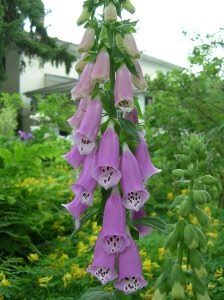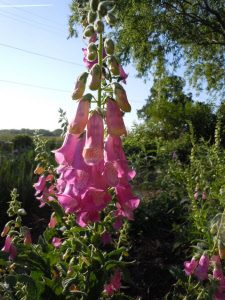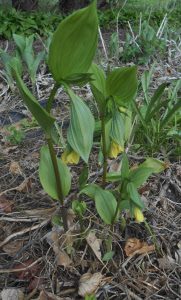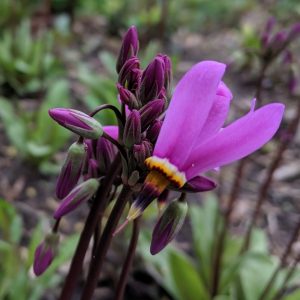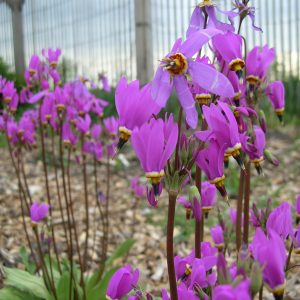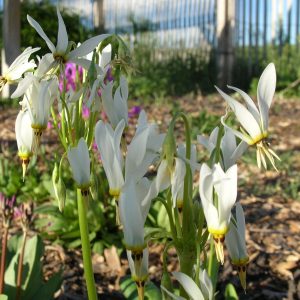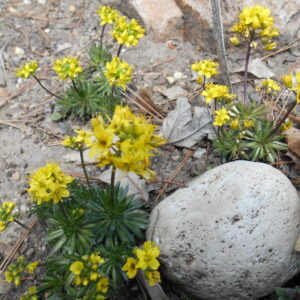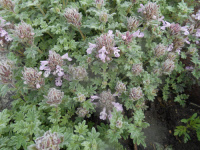Perennials & Biennials
Showing 153–160 of 511 results
-
Digitalis purpurea Foxglove Z 4-8
pink, purple or white spires of spotted bells
OUT OF STOCK
Early summer pink, purple or white spires of spotted bells. Beautiful.
Size: 3-5' x 24"
Care: Part shade moist well-drained soil. Deer resistant
Native: Great Britain,west and central Europe east to Scandinavia, often escapes.Druids were fond of this Foxglove because it flowered at the same time as their midsummer sacrifice. First described by German physician and botanical author Leonhard Fuchs (1501-1566). Grown in Medieval gardens. The plant’s use as a heart stimulant was discovered in 1775 by English physician William Withering. The word ‘fox’ is said to be a corruption of ‘folk,’ meaning the ‘little folk’ or fairies,” having the power to ward off witches and return children kidnapped by fairies. Cultivated in America since 1700’s, with the first documented reference of American cultivation in 1748 by Peter Kalm, a student of Linneaus and a Swedish botanist who explored colonial America for plants. Pressed specimen in Emily Dickinson’s herbarium.
-
Digitalis thapsi Spanish foxglove Z 5-9
Spikes of purple, rose-spotted trumpets in early summer. True perennial
Spikes of purple, rose-spotted trumpets in early summer. True perennial.
Size: 18” x 12”
Care: sun to part shade in moist well-drained soil.
Native: Spain & PortugalGrown in the botanical gardens of Moscow by 1752. Philip Miller (1691-1771), chief gardener at London’s Chelsea Physic Garden, received seeds from Spain and grew this by 1760’s
-
Disporum flavens Fairy bells Z 4-9
Upright stems, arch on top where moon-yellow bells dangle, elegant counterpoint to spring perennials
Moon-yellow bells dangle at the top of tall, upright stems. Elegant counterpoint to spring perennials
Size: 25-30” x 16-20”
Care: shade to part shade in moist-well-drained soil
Native: KoreaCollected in 1926 in Manchuria and described in Botanical Magazine (Tokyo) in 1934.
-
Dodecatheon jefferyi syn. Primula jefferyi Sierra shooting star, Tall mountain shooting star Z 5-8 Ephemeral
Fuschia, reflexed petals, looking like a descending shuttlecock or, as named, a shooting star, dangle from stems in late spring to early summer
OUT OF STOCK
Fuschia, reflexed petals, looking like a descending shuttlecock or, as named, a shooting star, dangle from stems in late spring to early summer
Size: 18-24” x 14-18”
Care: sun to part shade in moist to moist well-drained soil
Native: Pacific NW Alaska- CA & east in Montana and IdahoFirst collected by Meriwether Lewis on the Expedition at the Dalles of the Columbia River on April 16, 1806. Named for Scottish botanist John Jeffrey, who collected it and explored the Okanagan and Fraser regions with the Hudson Bay Co. in 1851-53.
-
Dodecatheon meadia syn. Primula meadia Pink Shooting Star Z 4-8 Ephemeral
Rosy-lilac reflexed flowers, looking like a descending shuttlecock, dangle from stems in spring
OUT OF STOCK – EMAIL FOR AVAILABILITY
Only available for purchase in spring – Ephemeral
Rosy-lilac reflexed flowers, looking like a descending shuttlecock, dangle from stems in spring
Size: 12-24” x 6-12”
Care: sun to part shade in moist well-drained soil.
Native: PA to Wisconsin, south to TX.
Awards: Royal Horticultural Society Award of MeritName Dodecatheon from the Greek dodeka (twelve) and theos (gods), meaning 12 superior gods, after the name given to another plant by Roman author, Pliny the Elder. The species name meadia after Richard Mead, physician to George III. John Tradescant the Younger sent this to England by 1640. “A favorite among old border flowers.” William Robinson, 1899.
-
Dodecatheon meadia syn. Primula meadia Shooting Star Z 4-8 Ephemeral
White reflexed flowers, looking like a descending shuttlecock, dangle from stems in spring. Ephemeral.
Available to order in Spring only
White reflexed flowers, looking like a descending schuttlecock, dangle from stems in spring. Ephemeral.
Size: 12” x 6”
Care: part shade in moist well-drained soil.
Native: PA to Wisconsin, south to TX.
Awards: England’s Royal Horticultural Society Award of Merit.Dodecatheon from the Greek dodeka (twelve) and theos (gods), meaning 12 superior gods, after the name given to another plant by Roman author, Pliny the Elder. The species name meadia after Richard Mead, physician to English King George III. John Tradescant the Younger sent this to England by 1640. “A favorite among old border flowers.” William Robinson, 1899.
-
Draba aizoides Yellow Whitlow grass Z 3-8
Tiny yellow flowers in very early spring over succulent, evergreen cushions
Tiny yellow flowers in very early spring over succulent, evergreen cushions.
Size: 1” x 1”
Care: Full sun in well-drained soil.
Native: EuropeListed in Sanders’ Flower Garden, described this as “dwarf, compact-growing alpine, suitable for growing on old walls or on dry, sunny rockeries.” (1913) Draba is the classical Greek name for this plant which poultice was said to remedy lesions on fingers Described and named in 1753.
-
Dracocephalum botryoides Dragonhead Z 4-7
Fuzzy, grey, deeply divided foliage with baby pink blossoms in May-June
Fuzzy, grey, deeply divided foliage with baby pink blossoms in May-June
Size: 5” x 18”
Care: sun to part shade in well-drained soil
Native: Caucasus on rocky, stony slopes, and screes where it is now endangered.
Wildlife Value: provides nectar and pollen for bees1st described in 1812. Dracocephalum means “dragonhead,” referring the shape of the flower.

